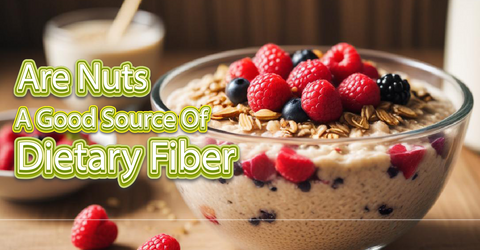We often focus on macronutrients like protein, carbohydrates, and fats. However, dietary fiber, another essential macronutrient, is frequently overlooked. This crucial component, abundant in foods like nuts, plays a vital role in our overall health.
What is Dietary Fiber?

Dietary fiber, exclusively derived from plants, is a macronutrient categorized into soluble and insoluble types. Each possesses distinct properties and functions within the body.
What is our Body Daily Fiber Requirement?
According to Singapore’s Health Promotion Board, the recommended daily dietary fiber intake is 10 grams per 1000 calories. This translates to approximately 20 grams for women and 26 grams for men. While these numbers might not seem substantial, many of us fall short of meeting these daily fiber needs due to dietary choices lacking in fiber-rich foods.
Soluble Fiber
Soluble fiber forms a gel-like substance when interacting with water in the digestive system. This gel-like nature contributes to its descriptive terms "gummy" or "viscous." By slowing down digestion, soluble fiber helps regulate blood sugar levels and reduce cholesterol absorption.
Insoluble Fiber
Unlike its soluble counterpart, insoluble fiber maintains its structure. It adds bulk to stools, promoting regular bowel movements and preventing constipation. Nuts are a prime example of a food rich in insoluble fiber.
Health Benefits of Dietary Fiber

Dietary fiber is fundamental to overall well-being. It supports digestive health, stabilizes blood sugar levels, improves heart health, and aids in weight management.
Improve Digestion
Fiber bulks up stools, ensuring smooth passage and preventing constipation. It also speeds up waste removal, reducing harmful substance exposure.
Blood Sugar Balance
Soluble fiber acts as a steady hand, preventing rapid blood sugar spikes and supporting diabetes management.
Cholesterol Control
By binding to cholesterol-carrying substances, soluble fiber helps lower "bad" cholesterol levels, promoting heart health.
Weight Management Ally
High-fiber foods fill you up faster, curbing overeating and helping you maintain a healthy weight.
Nuts Dietary Fiber Content

The fiber content in nuts varies. For a detailed comparison, refer to the accompanying table outlining fiber content in different nuts.
| Nuts | Fiber Content(g) |
| Almonds | 3.5 |
| Pistachios | 2.9 |
| Pecans | 2.7 |
| Macadamias | 2.4 |
| Peanuts | 2.3 |
| Walnuts | 1.9 |
| Cashews | 0.8 |
Based on the table, a single-ounce serving of almonds can contribute approximately 17.5% to the daily recommended fiber intake. This highlights the significant role nuts can play in boosting dietary fiber consumption.
Incorporating Nuts into Your Diet
There are several ways we can add nuts to our meals, such as stirring vegetables with cashews, making almond milk, or using walnuts in baking a banana walnut cake. Otherwise, we can consume nuts as a healthy snack. With all the good stuff in nuts, moderation eating is recommended while having other food to have a more rounded nutrition intake.
Fiber: The Unsung Hero
While protein, carbohydrates, and fats often take center stage in our diets, fiber is an equally crucial nutrient. Abundant in plant-based foods like nuts, seeds, and whole grains, fiber plays a vital role in overall health.
Fiber, an essential component of our diet, exists in two primary forms: soluble and insoluble. Both contribute significantly to our well-being. Daily fiber intake recommendations vary but generally range from 20 to 26 grams for adults. Unfortunately, many people may fall short of this target.
Fiber offers numerous health benefits, including improved digestion, blood sugar control, heart health, and weight management. Nuts, along with other fiber-rich foods, are essential for meeting daily fiber requirements. By making conscious food choices, we can increase our fiber intake and reap the rewards.
Reference List
Health Promotion Board Singapore. (n.d.). Dietary fibre: Health benefits & sources of fibre. [Website]. Health Xchange. Available at: https://www.healthxchange.sg/food-nutrition/food-tips/dietary-fibre-health-benefits-sources-fibre [Accessed 31 July 2024].
Health Promotion Board Singapore. (n.d.). Are you eating enough fibre? [Website]. Health Xchange. Available at: https://www.healthxchange.sg/food-nutrition/food-tips/are-you-eating-enough-fibre [Accessed 31 July 2024]
Nutrient data from United States Department of Agriculture (USDA) FoodData Central (fdc.nal.usda.gov), accessed July 31, 2024





